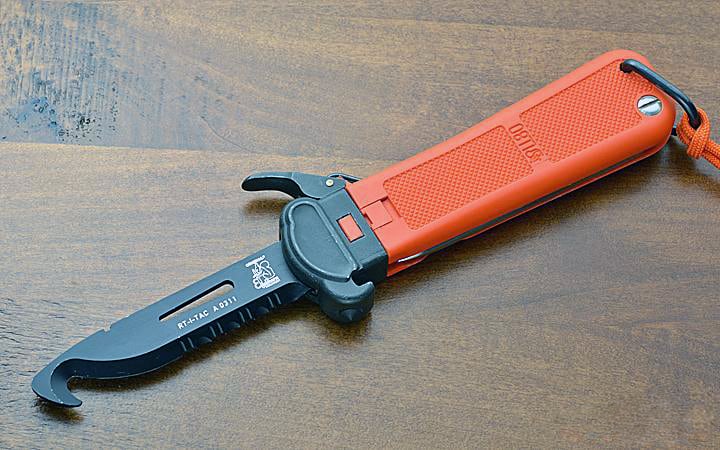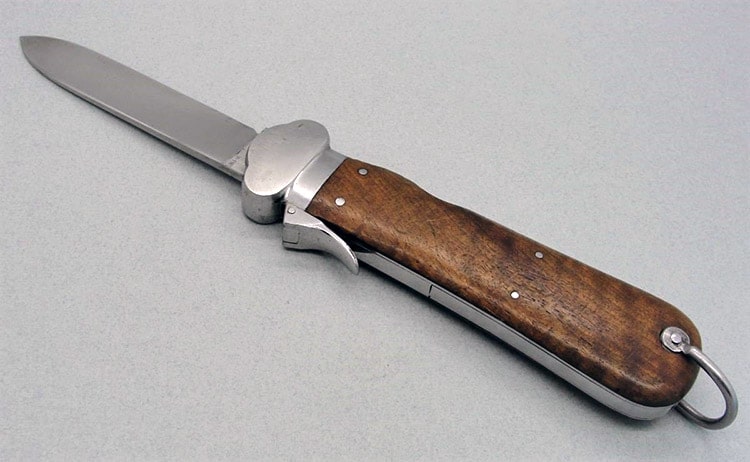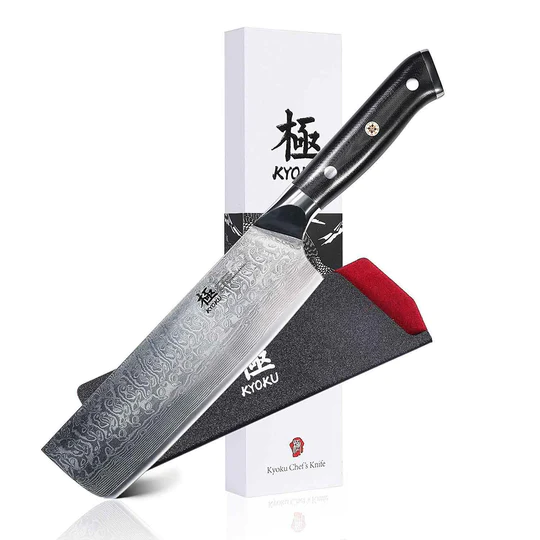


Gravity knives can be easily opened with one hand which makes them handy for everyday carry and using the blade in tight spaces. But it is a good idea to know your local laws before buying these knives, or transporting them over state lines.
Military grade gravity knives have been around for more than 75 years, yet they continue to attract controversy. These practical knives were first used by German parachutists during World War 2.
The Germans’ fixed blade knives required two hands to open and were were difficult to use. The delay in cutting free from their rigging increased the risk of being caught by enemy forces. This led to the invention of the gravity knife that could be opened quickly with one hand.
Up to 1950 it was legal in the US to carry the knife for personal and military uses. Gravity knives then gained popularity with street gangs.
The Switchblade Knife Act was introduced in 1958. This law banned the import, manufacture, and commercial sale of switchblades, gravity, and automatic knives.

US state knife laws have now changed across the country. In states like Tennessee and Texas, you’re good to go. US citizens can carry a range of auto-open knives including gravity knives and switchblades.
States and cities that used to have tough rules such as New York have made gravity knives legal to possess and carry. But in states like California you will run into blade length limits. There have been similar restrictions on gravity knives in Delaware and New Jersey.
Outside the US, the laws are tougher. Many countries treat gravity knives as weapons, so importing or carrying one in public is a big no-no. If you are traveling or moving with a gravity knife, double-check the rules. Seriously, don’t skip this step.
While militarily grade knives are hard to come by, Reate Knives and Daily Carry Co make a range of high end gravity knives:
Big retail stores like Amazon and Walmart also sell consumer grade gravity knives and novelty items.
Gravity knives pop open with a button, lever, or just a quick movement. They’re a fast to deploy, and that’s why some places have stricter laws compared to regular folding knives.
Gravity knives and switchblades look similar at a glance, but they work differently. Both knives have blades hidden in their handles. But, they use different mechanisms for opening. Gravity knives have a locking lever. When released, the blade drops. Switchblades use a spring inside the handle. When you push the button, the blade flicks open.
Gravity knives rely on gravity or wrist movement with no spring involved. This matters because the law usually treats these two types differently. Switchblades tend to get stricter treatment because of their automatic action.
If you’re into knives, it’s pretty important to know the difference. Confusing the two can get you in hot water, depending on where you are located.

In contrast to gravity knives, most folding knives need your thumb or another finger to open via nail groove, thumb stud, or a hole in the blade. Folding knives can also take two hands or manual effort to open.
| Feature | Gravity Knife | Standard Folding Knife |
|---|---|---|
| Opening Mechanism | Gravity or flick | Thumb or nail |
| One-Handed Operation | Yes | Sometimes |
| Locking System | Usually present | Often present |
Since WW2 the German military has created several variations on the German Luftwaffe Gravity Knife (LGK). The Type I LGK Gravity Knife, also called the Luftwaffe Fallschirmjager-Messer, was first manufactured in Germany in 1937. It featured wood scales on the handle and was strictly for cutting parachute ropes.
In the 1970s the knife evolved with a plastic polymer handle, rather than wood. This change made the handles more durable and resistant to moisture.
Eickhorn Soligen manufactures the current Type V gravity knife. This knife is smaller than previous models and is easier to assemble because it uses fewer parts. The Type V is used by the Swiss Air Force and the German military.

A large number of militaries have designed their own gravity knives. The British Government was one of the first after confiscating Type I knives from German soldiers. This knife was manufactured by George Ibberson & Co and was used as a secondary combat knife by the Special Operation Executive (SOE) and other wartime units.
It featured a handle made of smooth wood or sometimes plastic. Many features were identical to the German Type I knives, including a locking mechanism, gravity-deployed blade, and folding spike or awl.

As the gravity knife’s popularity spread to other countries new attachments have been added to the gravity knife.
For example, the marlin spike was designed for marine rope work and was useful for untangling knots. The awl could be used for piercing, prying things open, and fixing jammed weapons. These attachments folded into the knife.

Using a gravity knife responsibly starts with understanding how it affects safety—for you and everyone else. Careful handling, secure storage, and picking the right knife all matter.
Gravity knives sometimes get a bad rap because they open so easily and quickly. That makes them tempting for misuse, at least in the eyes of lawmakers and the public.
In some cities and states, you can’t carry them in public, especially in crowded places or spots where knife problems have happened before. If you’re carrying a gravity knife, follow local laws. You don’t want unwanted attention or legal headaches.
Accidental injury is a real risk, too. Since these knives can open with barely any effort, you might cut yourself if you’re not paying attention. Keep the knife closed when you’re not using it, and don’t show it off in crowded or sensitive spots.
Start by learning how your gravity knife works. Practice opening and closing it somewhere safe until you feel confident. Don’t use it while distracted, and keep it away from kids.
Store your knife folded and locked. A pouch or a secure pocket helps prevent it from popping open or getting lost.
Here’s a quick checklist for taking care of your knife:
It’s just common sense, really—keeps you and everyone around you safer.
Picking the right gravity knife makes a big difference for safety and satisfaction. Go for models with quality steel and a locking mechanism that feels solid. Handles with a good grip help you keep control.
Look for brands that get positive feedback from knife enthusiasts—they usually build in better safety features. Make sure it feels good in your hand and suits what you actually plan to do with it.
Some people like extra safety locks or features that slow down how fast the knife opens. If you’re new to gravity knives, it’s not a bad idea to pick something with those extras. It’s just one less thing to worry about.

Gravity knife laws can depend on where you live, how the knife works, and why you’re carrying it. Rules might be different if you’re a collector versus someone who wants a knife for daily use.
States like Texas let you carry gravity knives without much hassle. In New York, they became legal to own in 2019 after a law change. On the flip side, places like the UK ban them outright.
Local and city laws can add more restrictions, so always check your local rules before carrying one.
A gravity knife opens by gravity or a flick of the wrist. An automatic knife, or switchblade, uses a button or switch to fire the blade out with a spring.
This difference matters because the law often treats them differently. Knowing which one you have helps you stay legal.
Some lawmakers see gravity knives as riskier because you can open them fast with one hand. That quick action has led to concerns about crime or violence, and that’s why some places ban them.
In the UK, for example, the rules are strict—they’re illegal even for collectors.
If you carry a gravity knife somewhere it’s banned, you could get fined, arrested, or even face jail time. The penalty depends on local laws and whether you’ve got a record. The police might also confiscate your knife.
Every state cooks up its own knife laws. Some places let you carry gravity knives without much fuss, but others? They’ve got pretty strict bans. And just to keep things interesting, certain cities or counties might pile on extra restrictions beyond what the state says.
Honestly, it’s smart to check both state and local rules before you try carrying or buying a gravity knife. Saves a lot of headaches.
Yes. In many countries you are breaking the law just by owning a gravity knife, even if it never leaves your house. For example, in the UK gravity knives are totally banned, even for knife collectors.

Knife Buzz offers independent product reviews on a wide range of knives used in the kitchen, home, and outdoors. We make it easy for you to find the right knife at the best price.